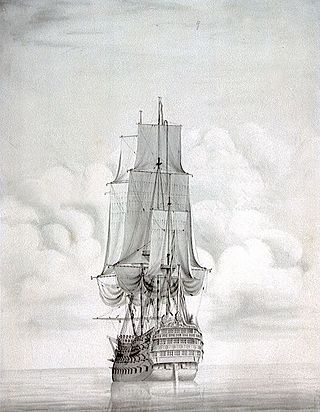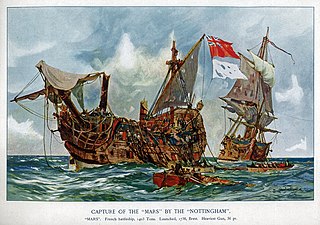
HMS Vanguard was a 90-gun second-rate ship of the line of the Royal Navy, built at Portsmouth Dockyard and launched in 1678.

HMS Cornwall was an 80-gun, third rate, ship of the line built for the Royal Navy in the 1690s. She served in the War of the Grand Alliance, and in her first year took part in the Battle of Barfleur and the action at La Hougue.

HMS Royal Oak was a 74-gun third-rate ship of the line of the Royal Navy, built by Jonas Shish at Deptford and launched in 1674. She was one of only three Royal Navy ships to be equipped with the Rupertinoe naval gun. Life aboard her when cruising in the Mediterranean Sea in 1679 is described in the diary of Henry Teonge.

HMS Nottingham was a 60-gun fourth-rate ship of the line of the Royal Navy, built at Deptford Dockyard and launched on 10 June 1703. She was the first ship to bear the name.

HMS Culloden was a 74-gun third-rate ship of the line of the Royal Navy, built according to the dimensions laid out by the 1741 proposals of the 1719 Establishment at Deptford Dockyard, and launched on 9 September 1747. She was the first ship to bear the name, and was named for the Battle of Culloden, which had been fought the previous year.

Ark Royal was an English galleon, originally ordered for Sir Walter Raleigh and later purchased by the crown for service in the Tudor navy. She was used as the English flagship in a number of engagements, including the battles that resulted in the defeat of the Spanish Armada, and had a long career spanning over 50 years. Her fame led to a number of later warships of the Royal Navy being named Ark Royal in her honour, including a number of flagships of the fleet.

HMS Royal Charles was a 100-gun first-rate ship of the line of the Royal Navy, designed and built by Sir Anthony Deane at Portsmouth Dockyard, where she was launched and completed by his successor as Master Shipwright, Daniel Furzer, in March 1673. She was one of only three Royal Navy ships to be equipped with the Rupertinoe naval gun.

HMS Royal Sovereign was a 100-gun first rate ship of the line of the Royal Navy, built at Woolwich Dockyard and launched in July 1701. She had been built using some of the salvageable timbers from the previous Royal Sovereign, which had been destroyed by fire in 1697.
Sainte Anne was a 64-gun ship of the line of the French Navy, launched in 1756. She was captured by the Royal Navy on 25 May 1761, and commissioned as the third rate HMS St Anne.

HMS St Michael was a 90-gun second rate ship of the line of the Royal Navy, built by John Tippetts of Portsmouth Dockyard and launched in 1669.

HMS St Andrew was a 96-gun first-rate ship of the line of the Royal Navy, built by Christopher Pett at Woolwich Dockyard under the supervision of Christopher Pett until his death in March 1668, completed by Jonas Shish, and launched in 1670. Commanded by George Churchill, she took part in the 1692 victory over the French navy at Barfleur & La Hogue.
Lyme was a 52-gun third rate Speaker-class frigate built for the navy of the Commonwealth of England at Portsmouth, and launched in 1654.

President was a 38-gun fourth rate frigate of the Royal Navy, originally built for the navy of the Commonwealth of England by Peter Pett I at Deptford Dockyard, and launched in 1650.
HMS Duchess was a 90-gun second rate ship of the line of the Royal Navy, built by John Shish at Deptford Dockyard, and launched in May 1679.
HMS Dorsetshire, the first Royal Navy ship to be named after the county of Dorset, was an 80-gun third rate ship of the line of the Royal Navy, launched at Southampton on 8 December 1694.

HMS Ipswich was a 70-gun third-rate ship of the line of the Royal Navy, launched at Harwich on 19 April 1694.

HMS Gloucester was a 50-gun fourth-rate ship of the line built at Deptford by Joseph Allin the elder for the Royal Navy in 1710/11. She participated in the War of the Spanish Succession. The ship was burned to prevent capture after she was damaged in a storm during Commodore George Anson's voyage around the world in 1742.

HMS Dreadnought was a 60-gun fourth rate ship of the line of the Royal Navy, built according to the 1733 proposals of the 1719 Establishment at Deptford, and was launched on 23 June 1742. Dreadnought served until 1784, when she was sold out of the service.

HMS Colchester was a 50-gun fourth rate ship of the line of the Royal Navy, built at Southampton according to the dimensions laid down in the 1741 proposals of the 1719 Establishment, and launched on 20 September 1745. She was ordered as a replacement for the previous HMS Colchester, which had been wrecked just two months after being launched.














